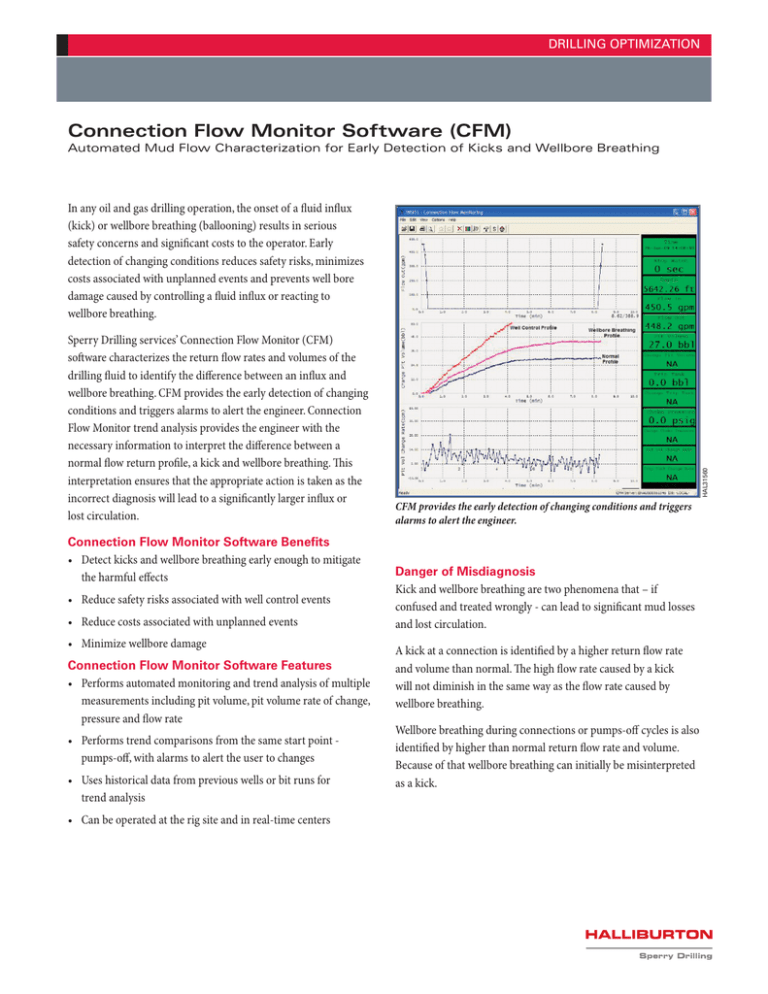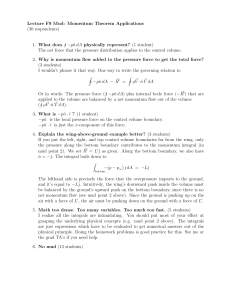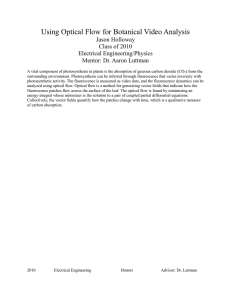
DRILLING OPTIMIZATION
Connection Flow Monitor Software (CFM)
Automated Mud Flow Characterization for Early Detection of Kicks and Wellbore Breathing
Sperry Drilling services’ Connection Flow Monitor (CFM)
software characterizes the return flow rates and volumes of the
drilling fluid to identify the difference between an influx and
wellbore breathing. CFM provides the early detection of changing
conditions and triggers alarms to alert the engineer. Connection
Flow Monitor trend analysis provides the engineer with the
necessary information to interpret the difference between a
normal flow return profile, a kick and wellbore breathing. This
interpretation ensures that the appropriate action is taken as the
incorrect diagnosis will lead to a significantly larger influx or
lost circulation.
Connection Flow Monitor Software Benefits
• Detect kicks and wellbore breathing early enough to mitigate
the harmful effects
• Reduce safety risks associated with well control events
• Reduce costs associated with unplanned events
• Minimize wellbore damage
Connection Flow Monitor Software Features
• Performs automated monitoring and trend analysis of multiple
measurements including pit volume, pit volume rate of change,
pressure and flow rate
• Performs trend comparisons from the same start point pumps-off, with alarms to alert the user to changes
• Uses historical data from previous wells or bit runs for
trend analysis
• Can be operated at the rig site and in real-time centers
HAL31560
In any oil and gas drilling operation, the onset of a fluid influx
(kick) or wellbore breathing (ballooning) results in serious
safety concerns and significant costs to the operator. Early
detection of changing conditions reduces safety risks, minimizes
costs associated with unplanned events and prevents well bore
damage caused by controlling a fluid influx or reacting to
wellbore breathing.
CFM provides the early detection of changing conditions and triggers
alarms to alert the engineer.
Danger of Misdiagnosis
Kick and wellbore breathing are two phenomena that – if
confused and treated wrongly - can lead to significant mud losses
and lost circulation.
A kick at a connection is identified by a higher return flow rate
and volume than normal. The high flow rate caused by a kick
will not diminish in the same way as the flow rate caused by
wellbore breathing.
Wellbore breathing during connections or pumps-off cycles is also
identified by higher than normal return flow rate and volume.
Because of that wellbore breathing can initially be misinterpreted
as a kick.
DRILLING OPTIMIZATION
However, the initial increase in the flow rate caused by wellbore
breathing will eventually subside. During circulation, the
equivalent circulating density is high enough to open fractures
and push mud into the formation. When the pumps are turned off,
the pressure decreases below the fracture closure pressure and
mud lost into the fractures is squeezed out back into the annulus.
This return of lost fluid causes a greater rate of mud return than
normal, eventually stopping when the fractures close.
A kick is controlled by increasing mud weight above the pore
pressure; wellbore breathing is controlled by mud weight
reduction. The consequence of misdiagnosis, where wellbore
breathing is diagnosed as a kick, leads to an increase in the mud
weight which results in greater mud losses and lost circulation.
Flow Rate Monitoring
Surface flow rate monitoring is the traditional method for early
kick detection. This method relies on flow meters or acoustic
devices to measure in and out flow rate and monitor for any
changes. However, many flow rate measurement devices in use
today have limited accuracy. Rig motion adds further inaccuracy
to flow rate interpretation leading to significant delays in
identifying a kick or wellbore breathing.
The CFM software establishes reference baselines and monitors
the behavior of a well during each connection from the instant the
mud pumps are shut down. Automated measurements of pit
volume total (PVT), pit volume rate of return, flow rate and
pressure are performed. Using multi-measurement trend analysis,
the CFM software fingerprints a normal connection profile
eliminating the uncertainty of traditional kick and wellbore
breathing detection methods. Deviations from a normal trend,
either from wellbore breathing or a kick will be quickly identified.
As pumps-off flow equalization is dependent on pumps-on flow
rate, the CFM software allows the user to save trend data from
multiple flow rates and use these for real-time comparison.
Historical connection trends from offset wells or previous bit runs
can be used as a reference for real-time trend comparisons to
determine the severity of a problem, such as wellbore breathing.
As part of Sperry Drilling services’ InSite system, the CFM
software is able to receive data either directly from sensors or via
industry-standard WITS or WITSML data transfer protocols. This
integration allows the CFM software to be run either at the rig site
or in a remote operations Center. Real-time data is available in the
InSite® system and on the web via the InSite® Anywhere service.
Drilling fluid volume in the rig’s surface flow lines is dependent
on the flow rate of the mud pumps. The higher the flow rate - the
greater the volume of mud in the surface lines. Therefore, the flow
rate used prior to a connection determines the volume and rate of
mud flow return to the pits. If flow rates differ between
connections, the mud return characteristics will change, often
considerably. Characterizing flow return and flow rate is key to
developing a full understanding of the flow return behavior from
the well during a connection.
For more information, contact us at sperry@halliburton.com
© 2009 Halliburton. All rights reserved. Sales of Halliburton products and services will be in accord solely with the terms and conditions contained in the
contract between Halliburton and the customer that is applicable to the sale.
H07132 8/09
www.halliburton.com










